Strategy Development Tools: Analyzing the Australian Tourism Industry
VerifiedAdded on 2023/06/12
|7
|1725
|344
Essay
AI Summary
This essay explores the future of the Australian tourism industry by analyzing the application of strategy development tools such as PESTEL, Porter's Five Forces, and SWOT analysis. It emphasizes the significance of understanding both internal and external factors influencing the industry's growth and stability. The PESTEL analysis examines political, economic, social, technological, environmental, and legal constraints, while Porter's Five Forces model assesses competitive rivalry, supplier power, buyer power, the threat of substitution, and potential new entrants. SWOT analysis combines internal strengths and weaknesses with external opportunities and threats. The essay concludes that these tools are crucial for the Australian government and tourism industry stakeholders to make informed decisions and maintain a competitive edge in the global market, especially given the increasing competition from other Asian countries.
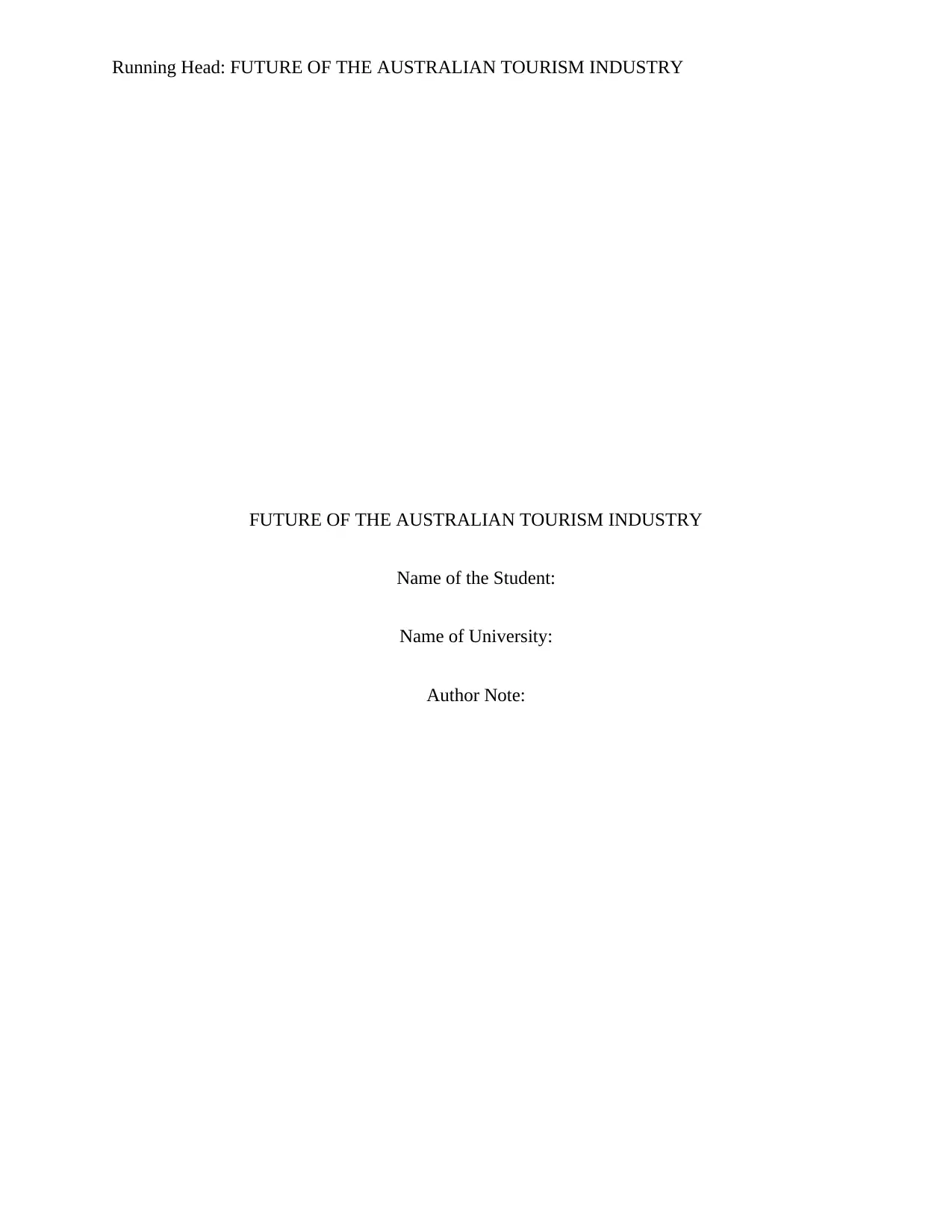
Running Head: FUTURE OF THE AUSTRALIAN TOURISM INDUSTRY
FUTURE OF THE AUSTRALIAN TOURISM INDUSTRY
Name of the Student:
Name of University:
Author Note:
FUTURE OF THE AUSTRALIAN TOURISM INDUSTRY
Name of the Student:
Name of University:
Author Note:
Paraphrase This Document
Need a fresh take? Get an instant paraphrase of this document with our AI Paraphraser
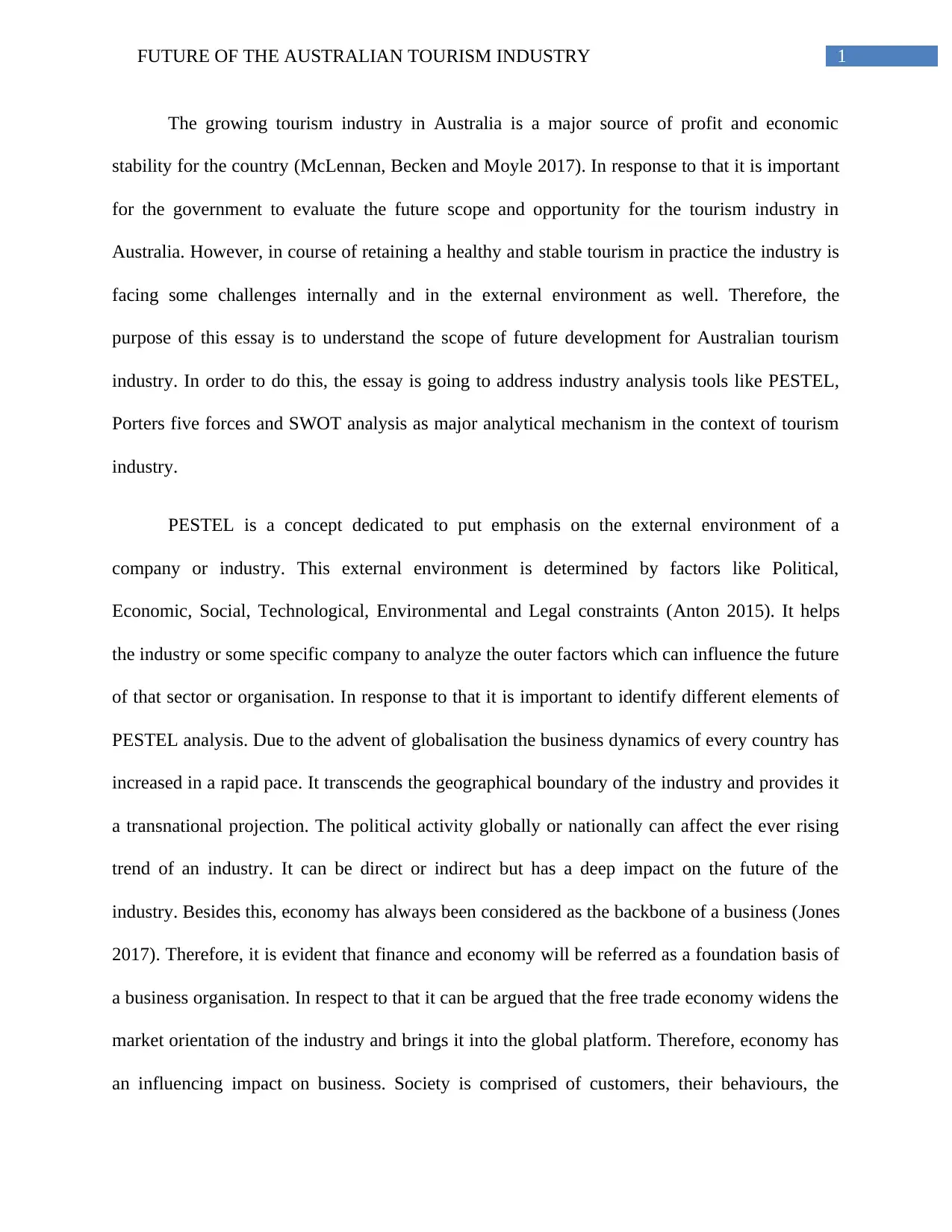
1FUTURE OF THE AUSTRALIAN TOURISM INDUSTRY
The growing tourism industry in Australia is a major source of profit and economic
stability for the country (McLennan, Becken and Moyle 2017). In response to that it is important
for the government to evaluate the future scope and opportunity for the tourism industry in
Australia. However, in course of retaining a healthy and stable tourism in practice the industry is
facing some challenges internally and in the external environment as well. Therefore, the
purpose of this essay is to understand the scope of future development for Australian tourism
industry. In order to do this, the essay is going to address industry analysis tools like PESTEL,
Porters five forces and SWOT analysis as major analytical mechanism in the context of tourism
industry.
PESTEL is a concept dedicated to put emphasis on the external environment of a
company or industry. This external environment is determined by factors like Political,
Economic, Social, Technological, Environmental and Legal constraints (Anton 2015). It helps
the industry or some specific company to analyze the outer factors which can influence the future
of that sector or organisation. In response to that it is important to identify different elements of
PESTEL analysis. Due to the advent of globalisation the business dynamics of every country has
increased in a rapid pace. It transcends the geographical boundary of the industry and provides it
a transnational projection. The political activity globally or nationally can affect the ever rising
trend of an industry. It can be direct or indirect but has a deep impact on the future of the
industry. Besides this, economy has always been considered as the backbone of a business (Jones
2017). Therefore, it is evident that finance and economy will be referred as a foundation basis of
a business organisation. In respect to that it can be argued that the free trade economy widens the
market orientation of the industry and brings it into the global platform. Therefore, economy has
an influencing impact on business. Society is comprised of customers, their behaviours, the
The growing tourism industry in Australia is a major source of profit and economic
stability for the country (McLennan, Becken and Moyle 2017). In response to that it is important
for the government to evaluate the future scope and opportunity for the tourism industry in
Australia. However, in course of retaining a healthy and stable tourism in practice the industry is
facing some challenges internally and in the external environment as well. Therefore, the
purpose of this essay is to understand the scope of future development for Australian tourism
industry. In order to do this, the essay is going to address industry analysis tools like PESTEL,
Porters five forces and SWOT analysis as major analytical mechanism in the context of tourism
industry.
PESTEL is a concept dedicated to put emphasis on the external environment of a
company or industry. This external environment is determined by factors like Political,
Economic, Social, Technological, Environmental and Legal constraints (Anton 2015). It helps
the industry or some specific company to analyze the outer factors which can influence the future
of that sector or organisation. In response to that it is important to identify different elements of
PESTEL analysis. Due to the advent of globalisation the business dynamics of every country has
increased in a rapid pace. It transcends the geographical boundary of the industry and provides it
a transnational projection. The political activity globally or nationally can affect the ever rising
trend of an industry. It can be direct or indirect but has a deep impact on the future of the
industry. Besides this, economy has always been considered as the backbone of a business (Jones
2017). Therefore, it is evident that finance and economy will be referred as a foundation basis of
a business organisation. In respect to that it can be argued that the free trade economy widens the
market orientation of the industry and brings it into the global platform. Therefore, economy has
an influencing impact on business. Society is comprised of customers, their behaviours, the
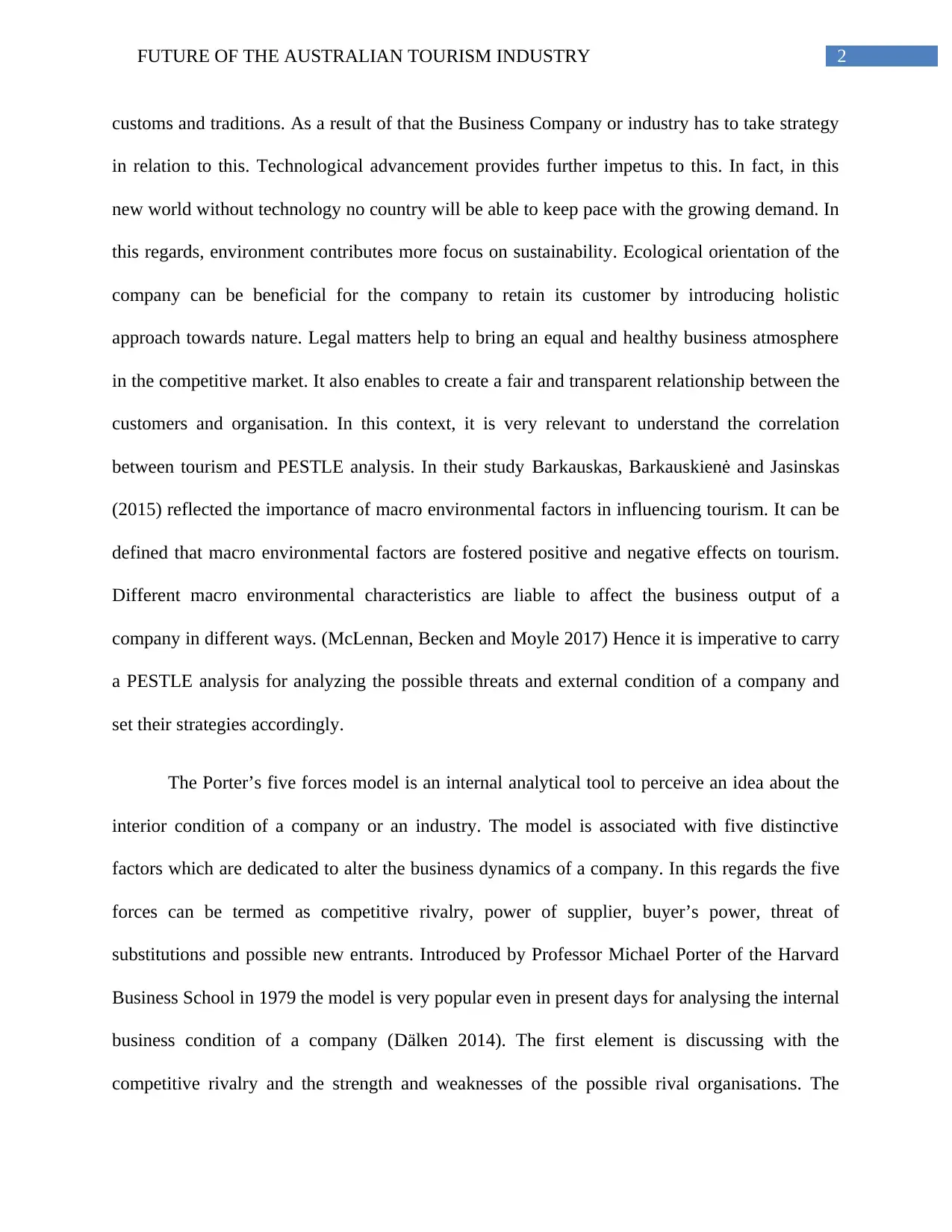
2FUTURE OF THE AUSTRALIAN TOURISM INDUSTRY
customs and traditions. As a result of that the Business Company or industry has to take strategy
in relation to this. Technological advancement provides further impetus to this. In fact, in this
new world without technology no country will be able to keep pace with the growing demand. In
this regards, environment contributes more focus on sustainability. Ecological orientation of the
company can be beneficial for the company to retain its customer by introducing holistic
approach towards nature. Legal matters help to bring an equal and healthy business atmosphere
in the competitive market. It also enables to create a fair and transparent relationship between the
customers and organisation. In this context, it is very relevant to understand the correlation
between tourism and PESTLE analysis. In their study Barkauskas, Barkauskienė and Jasinskas
(2015) reflected the importance of macro environmental factors in influencing tourism. It can be
defined that macro environmental factors are fostered positive and negative effects on tourism.
Different macro environmental characteristics are liable to affect the business output of a
company in different ways. (McLennan, Becken and Moyle 2017) Hence it is imperative to carry
a PESTLE analysis for analyzing the possible threats and external condition of a company and
set their strategies accordingly.
The Porter’s five forces model is an internal analytical tool to perceive an idea about the
interior condition of a company or an industry. The model is associated with five distinctive
factors which are dedicated to alter the business dynamics of a company. In this regards the five
forces can be termed as competitive rivalry, power of supplier, buyer’s power, threat of
substitutions and possible new entrants. Introduced by Professor Michael Porter of the Harvard
Business School in 1979 the model is very popular even in present days for analysing the internal
business condition of a company (Dälken 2014). The first element is discussing with the
competitive rivalry and the strength and weaknesses of the possible rival organisations. The
customs and traditions. As a result of that the Business Company or industry has to take strategy
in relation to this. Technological advancement provides further impetus to this. In fact, in this
new world without technology no country will be able to keep pace with the growing demand. In
this regards, environment contributes more focus on sustainability. Ecological orientation of the
company can be beneficial for the company to retain its customer by introducing holistic
approach towards nature. Legal matters help to bring an equal and healthy business atmosphere
in the competitive market. It also enables to create a fair and transparent relationship between the
customers and organisation. In this context, it is very relevant to understand the correlation
between tourism and PESTLE analysis. In their study Barkauskas, Barkauskienė and Jasinskas
(2015) reflected the importance of macro environmental factors in influencing tourism. It can be
defined that macro environmental factors are fostered positive and negative effects on tourism.
Different macro environmental characteristics are liable to affect the business output of a
company in different ways. (McLennan, Becken and Moyle 2017) Hence it is imperative to carry
a PESTLE analysis for analyzing the possible threats and external condition of a company and
set their strategies accordingly.
The Porter’s five forces model is an internal analytical tool to perceive an idea about the
interior condition of a company or an industry. The model is associated with five distinctive
factors which are dedicated to alter the business dynamics of a company. In this regards the five
forces can be termed as competitive rivalry, power of supplier, buyer’s power, threat of
substitutions and possible new entrants. Introduced by Professor Michael Porter of the Harvard
Business School in 1979 the model is very popular even in present days for analysing the internal
business condition of a company (Dälken 2014). The first element is discussing with the
competitive rivalry and the strength and weaknesses of the possible rival organisations. The
⊘ This is a preview!⊘
Do you want full access?
Subscribe today to unlock all pages.

Trusted by 1+ million students worldwide
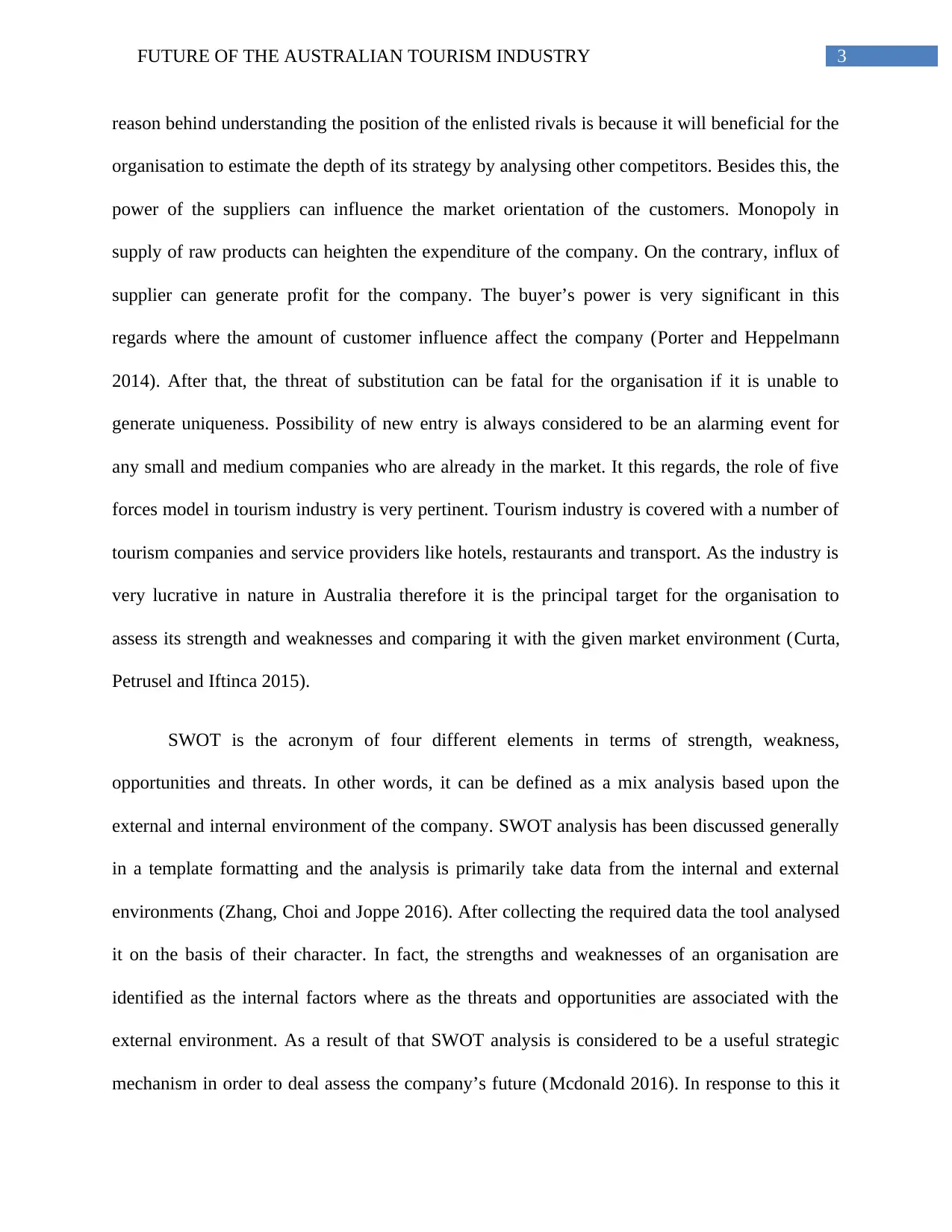
3FUTURE OF THE AUSTRALIAN TOURISM INDUSTRY
reason behind understanding the position of the enlisted rivals is because it will beneficial for the
organisation to estimate the depth of its strategy by analysing other competitors. Besides this, the
power of the suppliers can influence the market orientation of the customers. Monopoly in
supply of raw products can heighten the expenditure of the company. On the contrary, influx of
supplier can generate profit for the company. The buyer’s power is very significant in this
regards where the amount of customer influence affect the company (Porter and Heppelmann
2014). After that, the threat of substitution can be fatal for the organisation if it is unable to
generate uniqueness. Possibility of new entry is always considered to be an alarming event for
any small and medium companies who are already in the market. It this regards, the role of five
forces model in tourism industry is very pertinent. Tourism industry is covered with a number of
tourism companies and service providers like hotels, restaurants and transport. As the industry is
very lucrative in nature in Australia therefore it is the principal target for the organisation to
assess its strength and weaknesses and comparing it with the given market environment (Curta,
Petrusel and Iftinca 2015).
SWOT is the acronym of four different elements in terms of strength, weakness,
opportunities and threats. In other words, it can be defined as a mix analysis based upon the
external and internal environment of the company. SWOT analysis has been discussed generally
in a template formatting and the analysis is primarily take data from the internal and external
environments (Zhang, Choi and Joppe 2016). After collecting the required data the tool analysed
it on the basis of their character. In fact, the strengths and weaknesses of an organisation are
identified as the internal factors where as the threats and opportunities are associated with the
external environment. As a result of that SWOT analysis is considered to be a useful strategic
mechanism in order to deal assess the company’s future (Mcdonald 2016). In response to this it
reason behind understanding the position of the enlisted rivals is because it will beneficial for the
organisation to estimate the depth of its strategy by analysing other competitors. Besides this, the
power of the suppliers can influence the market orientation of the customers. Monopoly in
supply of raw products can heighten the expenditure of the company. On the contrary, influx of
supplier can generate profit for the company. The buyer’s power is very significant in this
regards where the amount of customer influence affect the company (Porter and Heppelmann
2014). After that, the threat of substitution can be fatal for the organisation if it is unable to
generate uniqueness. Possibility of new entry is always considered to be an alarming event for
any small and medium companies who are already in the market. It this regards, the role of five
forces model in tourism industry is very pertinent. Tourism industry is covered with a number of
tourism companies and service providers like hotels, restaurants and transport. As the industry is
very lucrative in nature in Australia therefore it is the principal target for the organisation to
assess its strength and weaknesses and comparing it with the given market environment (Curta,
Petrusel and Iftinca 2015).
SWOT is the acronym of four different elements in terms of strength, weakness,
opportunities and threats. In other words, it can be defined as a mix analysis based upon the
external and internal environment of the company. SWOT analysis has been discussed generally
in a template formatting and the analysis is primarily take data from the internal and external
environments (Zhang, Choi and Joppe 2016). After collecting the required data the tool analysed
it on the basis of their character. In fact, the strengths and weaknesses of an organisation are
identified as the internal factors where as the threats and opportunities are associated with the
external environment. As a result of that SWOT analysis is considered to be a useful strategic
mechanism in order to deal assess the company’s future (Mcdonald 2016). In response to this it
Paraphrase This Document
Need a fresh take? Get an instant paraphrase of this document with our AI Paraphraser
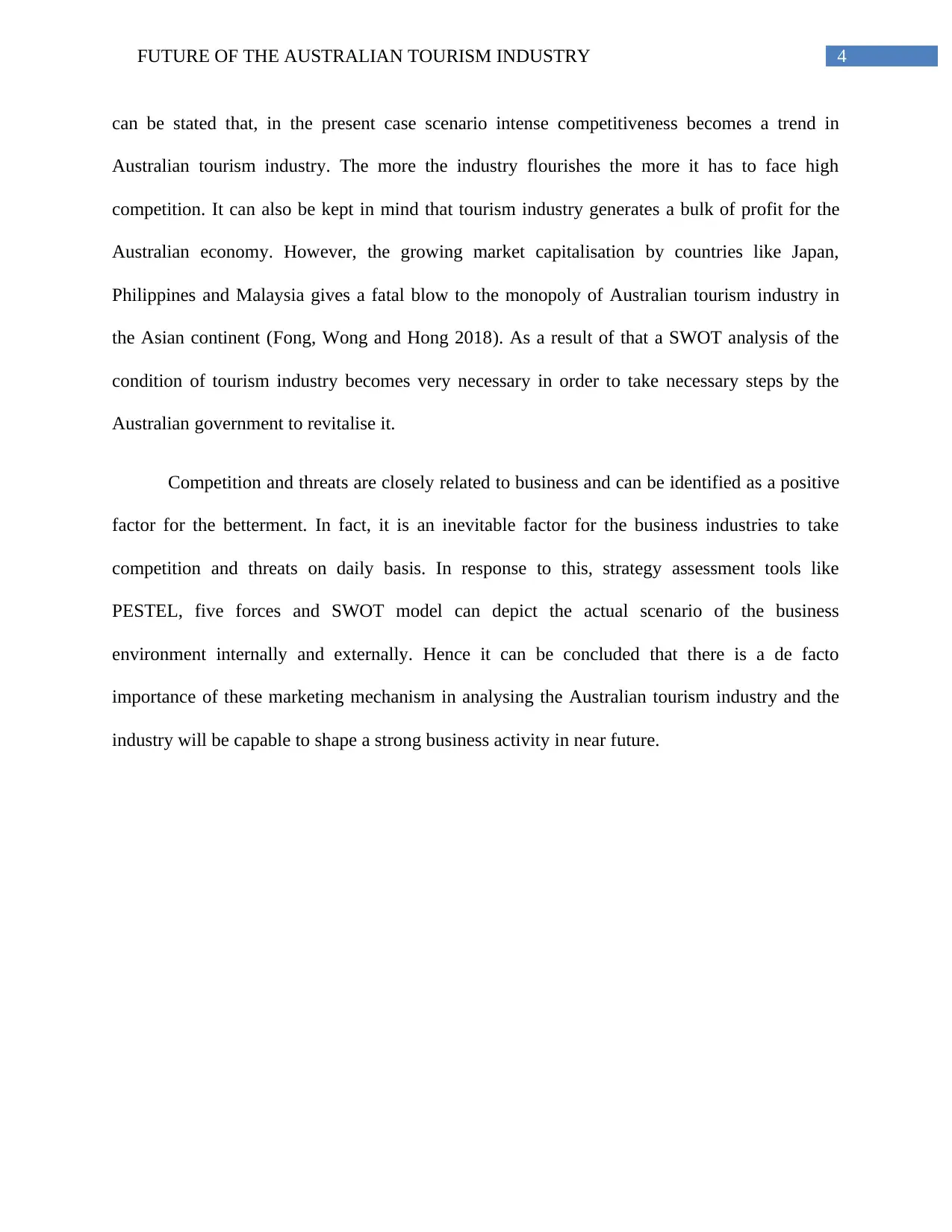
4FUTURE OF THE AUSTRALIAN TOURISM INDUSTRY
can be stated that, in the present case scenario intense competitiveness becomes a trend in
Australian tourism industry. The more the industry flourishes the more it has to face high
competition. It can also be kept in mind that tourism industry generates a bulk of profit for the
Australian economy. However, the growing market capitalisation by countries like Japan,
Philippines and Malaysia gives a fatal blow to the monopoly of Australian tourism industry in
the Asian continent (Fong, Wong and Hong 2018). As a result of that a SWOT analysis of the
condition of tourism industry becomes very necessary in order to take necessary steps by the
Australian government to revitalise it.
Competition and threats are closely related to business and can be identified as a positive
factor for the betterment. In fact, it is an inevitable factor for the business industries to take
competition and threats on daily basis. In response to this, strategy assessment tools like
PESTEL, five forces and SWOT model can depict the actual scenario of the business
environment internally and externally. Hence it can be concluded that there is a de facto
importance of these marketing mechanism in analysing the Australian tourism industry and the
industry will be capable to shape a strong business activity in near future.
can be stated that, in the present case scenario intense competitiveness becomes a trend in
Australian tourism industry. The more the industry flourishes the more it has to face high
competition. It can also be kept in mind that tourism industry generates a bulk of profit for the
Australian economy. However, the growing market capitalisation by countries like Japan,
Philippines and Malaysia gives a fatal blow to the monopoly of Australian tourism industry in
the Asian continent (Fong, Wong and Hong 2018). As a result of that a SWOT analysis of the
condition of tourism industry becomes very necessary in order to take necessary steps by the
Australian government to revitalise it.
Competition and threats are closely related to business and can be identified as a positive
factor for the betterment. In fact, it is an inevitable factor for the business industries to take
competition and threats on daily basis. In response to this, strategy assessment tools like
PESTEL, five forces and SWOT model can depict the actual scenario of the business
environment internally and externally. Hence it can be concluded that there is a de facto
importance of these marketing mechanism in analysing the Australian tourism industry and the
industry will be capable to shape a strong business activity in near future.
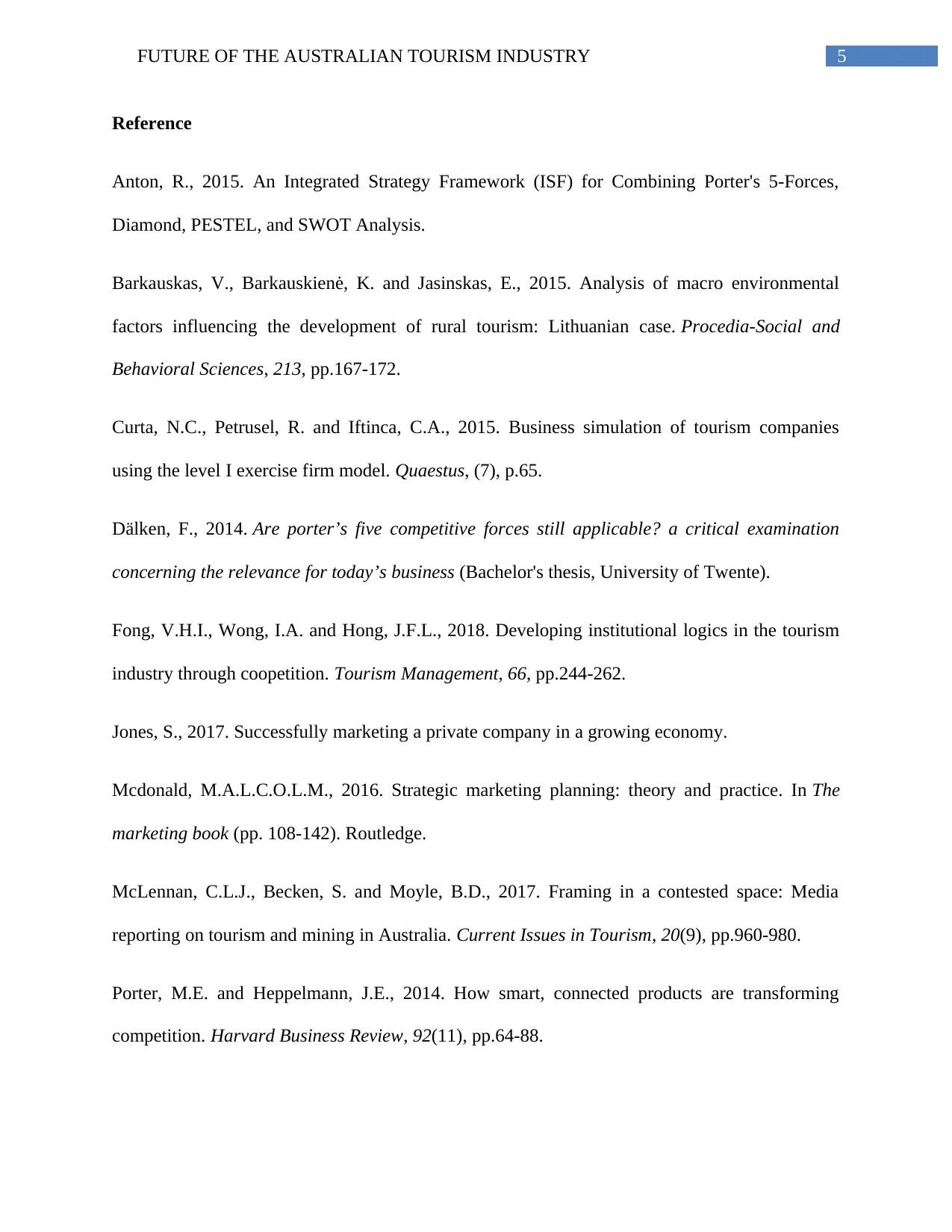
5FUTURE OF THE AUSTRALIAN TOURISM INDUSTRY
Reference
Anton, R., 2015. An Integrated Strategy Framework (ISF) for Combining Porter's 5-Forces,
Diamond, PESTEL, and SWOT Analysis.
Barkauskas, V., Barkauskienė, K. and Jasinskas, E., 2015. Analysis of macro environmental
factors influencing the development of rural tourism: Lithuanian case. Procedia-Social and
Behavioral Sciences, 213, pp.167-172.
Curta, N.C., Petrusel, R. and Iftinca, C.A., 2015. Business simulation of tourism companies
using the level I exercise firm model. Quaestus, (7), p.65.
Dälken, F., 2014. Are porter’s five competitive forces still applicable? a critical examination
concerning the relevance for today’s business (Bachelor's thesis, University of Twente).
Fong, V.H.I., Wong, I.A. and Hong, J.F.L., 2018. Developing institutional logics in the tourism
industry through coopetition. Tourism Management, 66, pp.244-262.
Jones, S., 2017. Successfully marketing a private company in a growing economy.
Mcdonald, M.A.L.C.O.L.M., 2016. Strategic marketing planning: theory and practice. In The
marketing book (pp. 108-142). Routledge.
McLennan, C.L.J., Becken, S. and Moyle, B.D., 2017. Framing in a contested space: Media
reporting on tourism and mining in Australia. Current Issues in Tourism, 20(9), pp.960-980.
Porter, M.E. and Heppelmann, J.E., 2014. How smart, connected products are transforming
competition. Harvard Business Review, 92(11), pp.64-88.
Reference
Anton, R., 2015. An Integrated Strategy Framework (ISF) for Combining Porter's 5-Forces,
Diamond, PESTEL, and SWOT Analysis.
Barkauskas, V., Barkauskienė, K. and Jasinskas, E., 2015. Analysis of macro environmental
factors influencing the development of rural tourism: Lithuanian case. Procedia-Social and
Behavioral Sciences, 213, pp.167-172.
Curta, N.C., Petrusel, R. and Iftinca, C.A., 2015. Business simulation of tourism companies
using the level I exercise firm model. Quaestus, (7), p.65.
Dälken, F., 2014. Are porter’s five competitive forces still applicable? a critical examination
concerning the relevance for today’s business (Bachelor's thesis, University of Twente).
Fong, V.H.I., Wong, I.A. and Hong, J.F.L., 2018. Developing institutional logics in the tourism
industry through coopetition. Tourism Management, 66, pp.244-262.
Jones, S., 2017. Successfully marketing a private company in a growing economy.
Mcdonald, M.A.L.C.O.L.M., 2016. Strategic marketing planning: theory and practice. In The
marketing book (pp. 108-142). Routledge.
McLennan, C.L.J., Becken, S. and Moyle, B.D., 2017. Framing in a contested space: Media
reporting on tourism and mining in Australia. Current Issues in Tourism, 20(9), pp.960-980.
Porter, M.E. and Heppelmann, J.E., 2014. How smart, connected products are transforming
competition. Harvard Business Review, 92(11), pp.64-88.
⊘ This is a preview!⊘
Do you want full access?
Subscribe today to unlock all pages.

Trusted by 1+ million students worldwide
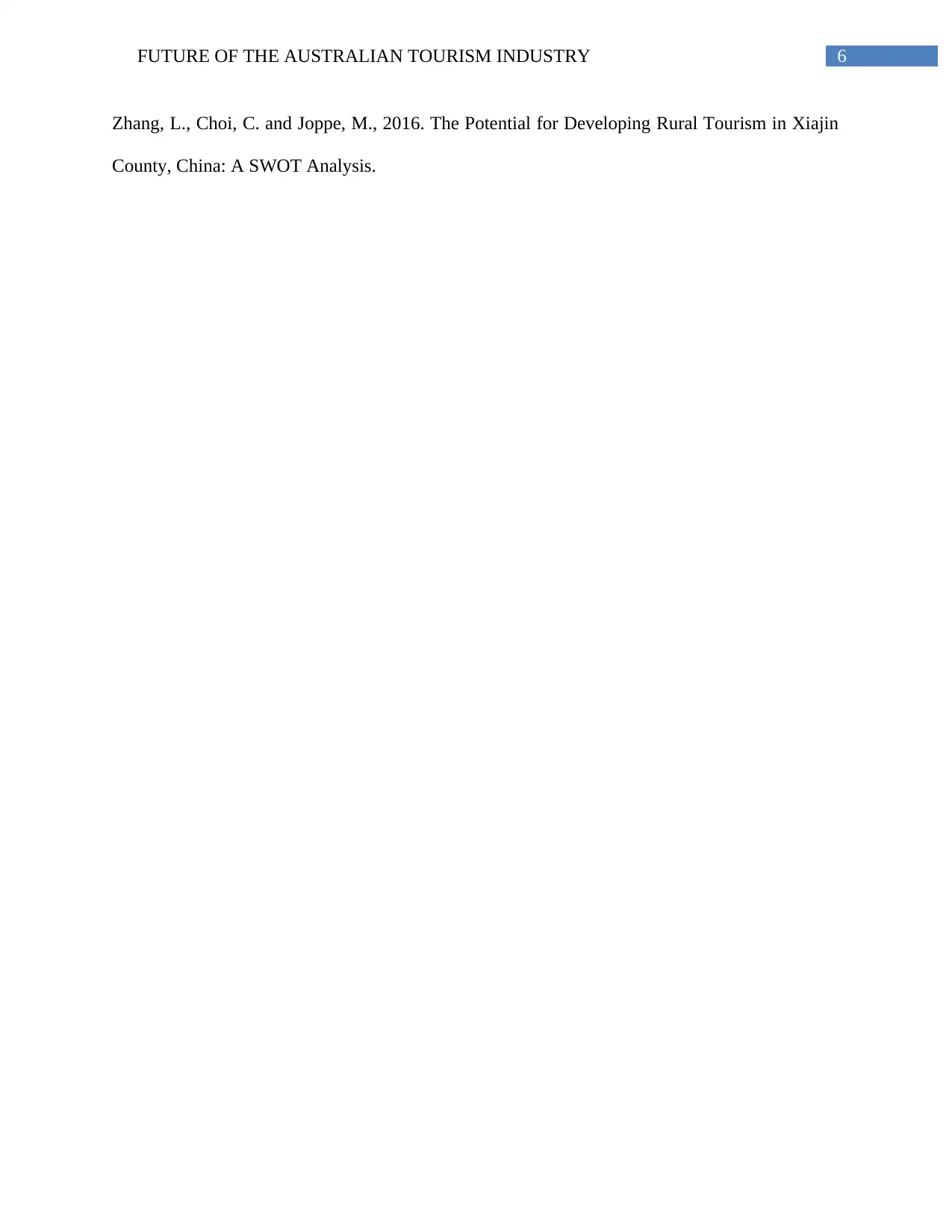
6FUTURE OF THE AUSTRALIAN TOURISM INDUSTRY
Zhang, L., Choi, C. and Joppe, M., 2016. The Potential for Developing Rural Tourism in Xiajin
County, China: A SWOT Analysis.
Zhang, L., Choi, C. and Joppe, M., 2016. The Potential for Developing Rural Tourism in Xiajin
County, China: A SWOT Analysis.
1 out of 7
Related Documents
Your All-in-One AI-Powered Toolkit for Academic Success.
+13062052269
info@desklib.com
Available 24*7 on WhatsApp / Email
![[object Object]](/_next/static/media/star-bottom.7253800d.svg)
Unlock your academic potential
Copyright © 2020–2025 A2Z Services. All Rights Reserved. Developed and managed by ZUCOL.





